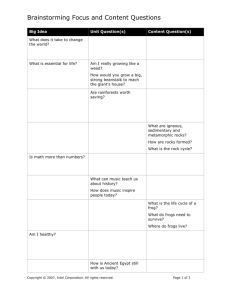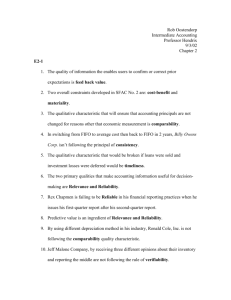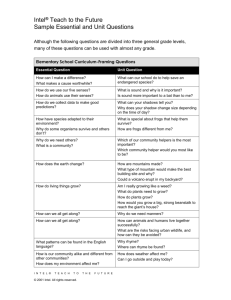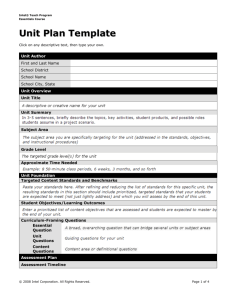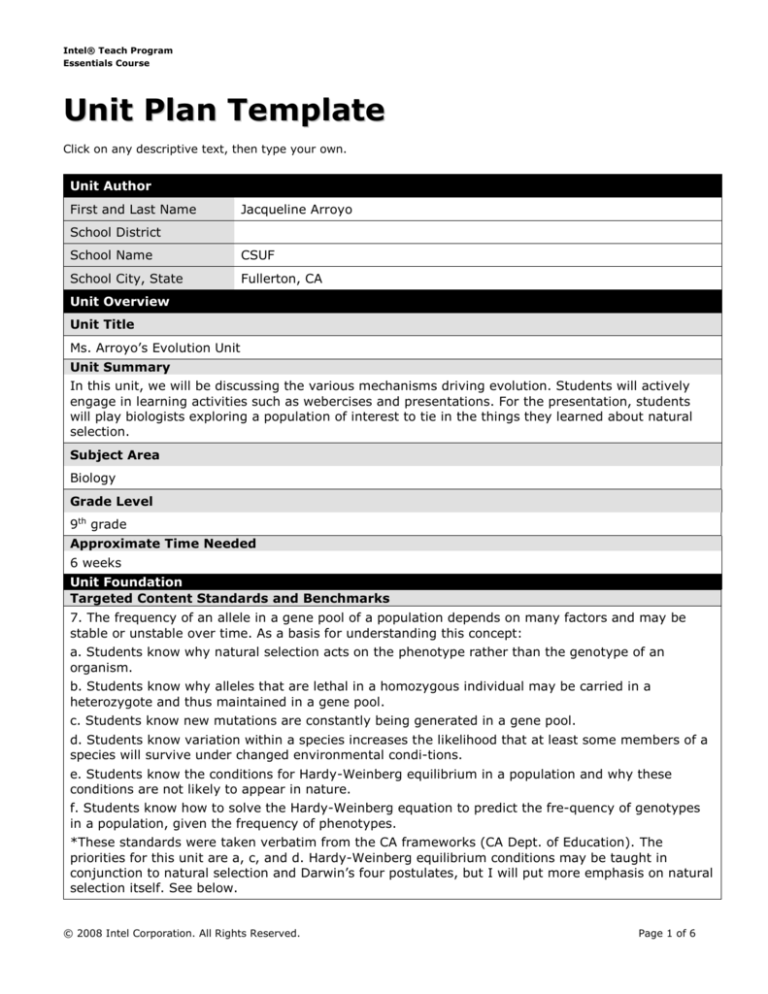
Intel® Teach Program
Essentials Course
Unit Plan Template
Click on any descriptive text, then type your own.
Unit Author
First and Last Name
Jacqueline Arroyo
School District
School Name
CSUF
School City, State
Fullerton, CA
Unit Overview
Unit Title
Ms. Arroyo’s Evolution Unit
Unit Summary
In this unit, we will be discussing the various mechanisms driving evolution. Students will actively
engage in learning activities such as webercises and presentations. For the presentation, students
will play biologists exploring a population of interest to tie in the things they learned about natural
selection.
Subject Area
Biology
Grade Level
9th grade
Approximate Time Needed
6 weeks
Unit Foundation
Targeted Content Standards and Benchmarks
7. The frequency of an allele in a gene pool of a population depends on many factors and may be
stable or unstable over time. As a basis for understanding this concept:
a. Students know why natural selection acts on the phenotype rather than the genotype of an
organism.
b. Students know why alleles that are lethal in a homozygous individual may be carried in a
heterozygote and thus maintained in a gene pool.
c. Students know new mutations are constantly being generated in a gene pool.
d. Students know variation within a species increases the likelihood that at least some members of a
species will survive under changed environmental condi-tions.
e. Students know the conditions for Hardy-Weinberg equilibrium in a population and why these
conditions are not likely to appear in nature.
f. Students know how to solve the Hardy-Weinberg equation to predict the fre-quency of genotypes
in a population, given the frequency of phenotypes.
*These standards were taken verbatim from the CA frameworks (CA Dept. of Education). The
priorities for this unit are a, c, and d. Hardy-Weinberg equilibrium conditions may be taught in
conjunction to natural selection and Darwin’s four postulates, but I will put more emphasis on natural
selection itself. See below.
© 2008 Intel Corporation. All Rights Reserved.
Page 1 of 6
Intel® Teach Program
Essentials Course
8. Evolution is the result of genetic changes that occur in constantly changing environments. As a
basis for understanding this concept:
a. Students know how natural selection determines the differential survival of groups of organisms.
b. Students know a great diversity of species increases the chance that at least some organisms
survive major changes in the environment.
c. Students know the effects of genetic drift on the diversity of organisms in a population.
d. Students know reproductive or geographic isolation affects speciation.
e. Students know how to analyze fossil evidence with regard to biological diversity, episodic
speciation, and mass extinction.
f. Students know how to use comparative embryology, DNA or protein sequence comparisons, and
other independent sources of data to create a branching dia-gram (cladogram) that shows probable
evolutionary relationships.
g. Students know how several independent molecular clocks, calibrated against each other and
combined with evidence from the fossil record, can help to estimate how long ago various groups of
organisms diverged evolutionarily from one another.
*These standards were taken verbatim from CA frameworks (CA Dept. of Education). Here,
standards a and b are the priorities in this unit. However, the others will not be ignored. Natural
selection is the main focus here because it’s the main mechanism behind evolution. Genetic drift is
another mechanism, but selection is more powerful. I will talk about speciation in the context of
natural selection because speciation events occur hand-in-hand with natural selection events (i.e.
natural selection acts separately and differently on the two new species). Its important to teach
students how to read and construct cladograms, since these depict evolutionary relationships. I will
focus on this at the end of the unit as a wrap-up. Because much of the unit will consist of natural
selection, the big assessment would be a presentation in which the students will create a population
that satisfies the four postulates. There will be smaller assessments for the other standards.
Student Objectives/Learning Outcomes
Students will analyze and evaluate evidence of natural selection as a mechanism behind evolution.
Students will work creatively with others to design hypothetical populations in order to explain how
multiple factors (mutations, environment, variation, etc.) affect these populations. They will use
careful language so as not to support any misconceptions about natural selection.
Students will defend their hypothetical populations by presenting their work and ideas in class.
Students will organize their thinking into graphic organizers.
Students will explore a variety of resources available to aid them in their learning.
Students will assess evolutionary relationships between organisms on cladograms.
Curriculum-Framing Questions
Essential
Question
Unit
Questions
Content
Questions
How do environmental factors and relationships among individuals affect
populations?
What does natural selection mean for individuals within populations (fit vs. less
fit)?
What are the four postulates Darwin hypothesized were necessary for natural
selection to occur? What are other mechanisms of evolution?
Assessment Plan
© 2008 Intel Corporation. All Rights Reserved.
Page 2 of 6
Intel® Teach Program
Essentials Course
Assessment Timeline
Before project work begins
KWL Chart
Lecture
w/questions
Class
Discussions
Students work on projects
and complete tasks
Terms puzzle
Online
Discussion
Misconception
Worksheet
Natural
selection
jellybean
activity
Population
brainstorm
After project work is
completed
Population
presentation
Evolution
Timeline
Phylogenetic
tree
webercise
Assessment Summary
KWL Chart & discussion- Students will work in groups of 4-5 to fill in a KWL chart. They will share
what they know (or think they know) about natural selection and evolution. They will also formulate
questions about things they want to know about the topic and discuss any ideas they may have. After
students have completed the KW portions, each group will share their ideas and questions to
construct a class chart. This will allow me to adjust the unit to encompass students’ preconceptions
and/or misconceptions about evolution and natural selection. The last portion of the KWL chart will be
filled in prior to completing the student presentations.
Misconceptions worksheet- This worksheet consists of common misconceptions about natural
selection and evolution. Prior to the first formal lecture/class discussion about natural selection,
students will check off the “agree/disagree” portion of the worksheet. After the lecture/discussion,
they will complete the worksheet by providing evidence against each of the statements. They are
welcome to use their class notes, textbook, or internet sources so long as they cite their references.
Terms puzzle- There are important terms for students to know and understand over the course of
this unit. They will be given a crisscross puzzle to fill out. Clues and/or definitions will be provided
and they will identify the terms.
Online survey & discussion- Students will complete a 5-question survey. They will then participate in
an online discussion to explain why they chose their answers over the other possible choices.
Natural Selection Jellybean Activity- Students will participate in a lab activity in which they will act as
“predators” and jellybeans will be their “prey.” Some prey (jellybean flavors) are more appealing to
predators (students). Just as predators have developed ways to obtain their prey, prey have
developed ways to avoid predation (mimicry, camouflage, etc.). This lab contains two activities. The
first will aid in teaching students about the three types of natural selection: directional, stabilizing,
and disruptive selection. The second will aid in teaching about selection pressures such as
competition. There will be a set of questions to answer and students will graph their results.
Popualation Brainstorm- The purpose of this activity is to prepare students for their presentation on
their hypothetical population. The hypothetical population does not have to be real, as in be about
© 2008 Intel Corporation. All Rights Reserved.
Page 3 of 6
Intel® Teach Program
Essentials Course
real animals. Students can get creative and create an alien or mythical creature population. Students
will work in groups of 4-5 to brainstorm ideas. The graphic organizer on which they will brainstorm
contains the four postulates needed for natural selection to occur. They must come up with situations
within their population that satisfy these criteria. The teacher will check these before going forward
with the presentation.
Population Presentation Guidelines & Rubric- After their population brainstorms have been approved,
they will be given: 1) a set of guidelines on what to include for the presentation and 2) a rubric that
encompasses both the content of the presentation and their presentation skills (eye contact, posture,
etc.). They will also use the rubric to assess the members of their group. Students will be given the
choice of presentation tools; they can use PowerPoint, Keynote, Sliderocket, Prezi, etc.
Phylogenetic tree webercise- Students will complete an online assignment on their own. This will be
the introduction into the last topic of the unit: cladograms or phylogenetic trees. After completion, we
will attempt to read a few more difficult trees, but will also practice constructing them. The webercise
will tell me how well they have understood the basics. If I sense that they are struggling, I will adjust
the pace.
Evolution timeline- Students will research on findings (fossils or otherwise) that pertain to evolution.
This activity requires critical thinking/higher-order thinking as they must analyze and assess the
evidence. In addition, students must think about the evidence’s importance (i.e. don’t just say it’s
important for evolution, but why).
Unit Details
Prerequisite Skills
•
Students will revisit knowledge from their previous biology course(s) pertaining to natural
selection and evolution.
•
Students will express their ability to make and interpret graphs.
•
Students will apply their understanding of the scientific method.
Instructional Procedures
I will begin by introducing natural selection in the form of a sliderocket presentation. There will be
discussion questions throughout the presentation for students to answer. Students will also be given
a guide to limit note-taking time and to allow them time to focus on what I will be saying. I expect
this intro to take a whole day because prior to the presentation, students will have filled out a KWL
chart. They will be given the misconceptions worksheet to work on. This will be the topic of
discussion the following day. We will focus a bit more on Darwin’s postulates to continue on the
presentation. We will talk about selective pressures such as environmental effects and predation. We
will participate in a jellybean lab activity to visualize the pressure of predation. Students will work on
terms at home. One of the next topics I will talk about is the type of natural selection (directional,
stabilizing and disruptive). The jellybean lab consists of two activities; the one about selection types
will be run the same day as the lecture on selection types. Students will be given a few questions for
homework to complete online- these will be the online discussions. After we have wrapped up
Darwin’s postulates and selection types, students will begin working on the population project for the
next week. They will be given class time. This is best because students will be able to ask me
questions directly. They will be given a rubric and guidelines. Presentations will then be presented to
the class. We will then move on to how evolution is expressed across the scientific community
(cladograms). They will be given a webercise in which they read background info and try to read
simple cladograms. In class the next day, I will give them a more detailed intro with plenty of
questions for them to answer and cladograms to practice reading. The last activity will be the
timeline. This brings multiple scientific disciplines together. The focus was first on fossils, but I later
decided to expand the focus a bit. They will be looking at biology, chemistry, paleontology, geology,
etc.
Accommodations for Differentiated Instruction
© 2008 Intel Corporation. All Rights Reserved.
Page 4 of 6
Intel® Teach Program
Essentials Course
Special Needs
Students
•
•
•
•
•
•
•
•
Nonnative
Speakers
K-W-L Chart.
Extended work time.
Assistance with calculations and graphing.
Group collaboration.
Presentation Slide Guide document (this decreases note-taking time during
lecture). This will be available to all.
Word wall for terms in the unit.
Graphic organizers (to assist them in making connections).
To assess students effectively, I will give them oral tests and allow them to
draw pictures to aid them in case they have difficulty finding the words to
explain themselves.
•
•
•
•
•
Group work with bilingual student(s). I am bilingual, so I can also assist them.
Incorporation of visuals into notes to build connection to key terms of the Unit.
K-W-L chart of evolution & natural selection.
Build connections between material to examples in first language and culture.
I will create tests in their native language (if in Spanish) or I will find a volunteer
to help them take the test.
•
Extended work time for deeper research into topics. The projects and
assessments will allow gifted students to go beyond what is required. This does
not mean they will be given busy work. I will talk to them about questions they
have pertaining to the topics of the projects. I will have them incorporate those
questions and interests into their projects.
Possible lecture to classmates or younger students in different classes.
Gifted/Talented
Students
•
Materials and Resources Required For Unit
Technology – Hardware (Click boxes of all equipment needed)
Camera
Laser Disk
VCR
Computer(s)
Printer
Video Camera
Digital Camera
Projection System
Video Conferencing Equip.
DVD Player
Scanner
Other
Internet Connection
Television
Technology – Software (Click boxes of all software needed.)
Database/Spreadsheet
Image Processing
Web Page Development
Desktop Publishing
Internet Web Browser
Word Processing
E-mail Software
Multimedia
Other
Encyclopedia on CD-ROM
Printed Materials
Textbook
Supplies
Jellybelly jellybeans for the natural selection activity!
© 2008 Intel Corporation. All Rights Reserved.
Page 5 of 6
Intel® Teach Program
Essentials Course
http://www.pbs.org/wgbh/evolution/
http://www.pbs.org/wgbh/nova/evolution/
http://en.wikipedia.org/wiki/Natural_selection
Internet Resources
http://evolution.berkeley.edu/evosite/evo101/IIIENaturalSelection.shtml
http://www.pbs.org/wgbh/evolution/library/01/6/l_016_01.html
http://www.bbc.co.uk/worldservice/sci_tech/highlights/011025_ccr5.shtml
http://science.discovery.com/interactives/literacy/darwin/darwin.html
Other Resources
I was thinking about making a “field trip” around the school to allow the
students to make plant observations. They have many adaptations that
would be neat for the class to see.
Copyright © 2008 Intel Corporation. All rights reserved. Intel, the Intel logo, Intel Education Initiative, and Intel Teach Program are trademarks
of Intel Corporation in the U.S. and other countries. *Other names and brands may be claimed as the property of others.
© 2000-2007 Intel Corporation. All Rights Reserved.
Page 6 of 6

